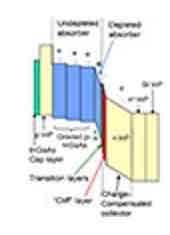Wafers for High-Power RF Avalanche Transit Time Diode Research
Wafers for Avalanche Transit Time Diode Research
A research client asked for the following:
We are presently doing research in the field of high-power RF Avalanche Transit Time diode development. For that we need to purchase GaN epiwafer on Si or SiC or Sapphire or GaN substrates. Please share the comparative price list so that the final order could be placed based on this. Tentative Specification: p+ (cap layer) : 5x10^25 / m^3 , 50 nm n+ : 1x10^26 / m^3 , 5 micron n layer : 5x10^23/m^3, 1 micron p-layer: 5x10^23/m^3 , 1 micron Substrate (n type) : Si, GaN, SiC and Sapphire : quote separately Please quote for unit processed epiwafer ( wafer dia, 4 inch / 6 inch / as per availability at your centre). Please make a table of all added details as you feel appropriate for fabrication team. In quotation, please mention, whether there is any condition of minumum number of purchase - accordingly , the final order would be placed.
Gallium Nitride on Sapphire, SiC
Silicon Carbide (SiC)
Silicon (Si)
Get Your Quote FAST!
What is High-Power RF Avalanche Transit Time Diode?
The IMPATT (Induced Plasma Avalanche Transit Time) diode has a very complex structure. The primary purpose of an IMPATT is to generate radio waves, and it is the most commonly used RF device today. Its basic characteristics are the same as those of the IMPATT, but its design is much more complicated. For example, in a single-cell RF receiver, an IMPATT is designed to operate at two different frequencies. This allows users to choose a high-power RF signal source that doesn't compromise on range.
Unlike conventional RF Avalanche Transmitters, the IMPATT Diode has a higher breakdown voltage than a traditional RF Avalanche Transistor. As a result, the RF Avalanche Transistor Diode  operates between hundreds of MHz and several GHz. A TRAPATT Diode has an n+-p-p-n+ structure with a depletion region of n-type. This plasma is extracted from the device with a voltage that is far higher than the pre-breakdown current.
operates between hundreds of MHz and several GHz. A TRAPATT Diode has an n+-p-p-n+ structure with a depletion region of n-type. This plasma is extracted from the device with a voltage that is far higher than the pre-breakdown current.
The IMPATT diode works by generating an avalanche of electrons in a region of the diode with a sufficient amount of energy. This is achieved through thermal generation. This leads to linear capacitance charging. When the field in the avalanche region is above its breakdown voltage, electrons drift towards the n+ region, resulting in a dense plasma.
The IMPATT diode family has different structures and junctions. The first oscillation was obtained with a silicon p-n junction diode mounted in a microwave cavity. The resulting plasma extraction and charging are the primary features of the IMPATT Diode. The IMPATT Diode is useful for a variety of RF applications. It can be used for radar, TV, and radio waves.
IMPATT diodes are used in microwave applications and are commonly referred to as "Crystals". The p-n-i-n junction is the simplest form of a p-n junction. The resulting n-n configurations in the IMPATT structure of the IMPATT are similar to the IMPATT Diode. Avalanche breakdown causes an abrupt increase in the current in the diode. This is what is called a Gunn oscillator characteristic.
Another RF Avalanche Transit Time diode, aka an IMPATT diode, is a type of semiconductor device that has a negative resistance. The IMPATT diode has four layers: a high-doping region and a drift region. As electrons move toward the contact, the holes drift to the corresponding area. The inversely-skewed avalanche structure of the IMPATT Diode is equivalent to a PNIN.
IMPATT diodes are high-power semiconductor devices that are used for microwave applications. They are characterized by a negative resistance characteristic and are essentially a microwave oscillator. Their structure is similar to a PIN diode, but their output frequency is much wider. Avalanche Transforms a CMOS photoelectric device.
The IMPATT diode is a reverse-biased PN junction, which results in a high current. The accumulated minority carriers, or 'holes', flow across the PN junction. A resulting avalanche current multiplies the number of electrons and holes. This process is known as an avalanche. In this case, the IMPATT has the highest potential peak power of all types of RF Avalanche Transients.
An IMPATT diode is a two terminal semiconductor device that operates on the principles of avalanche multiplication and transit time effects. It is a more advanced version of the Red diode, and is a highly advanced form of the PN junction. The IMPATT is made of silicon carbides and has a p+-n+ structure. It is a point-contact diode, whereas a PN-JET diode is a junction-type device.
The RF Avalanche transition process has many benefits, including its ability to provide a low-power solution to a variety of electromagnetic fields. The resulting RF Avalanche transience is a high-energy RF Avalanche diode. Its unique structure makes it an excellent choice for a wide range of RF applications.
